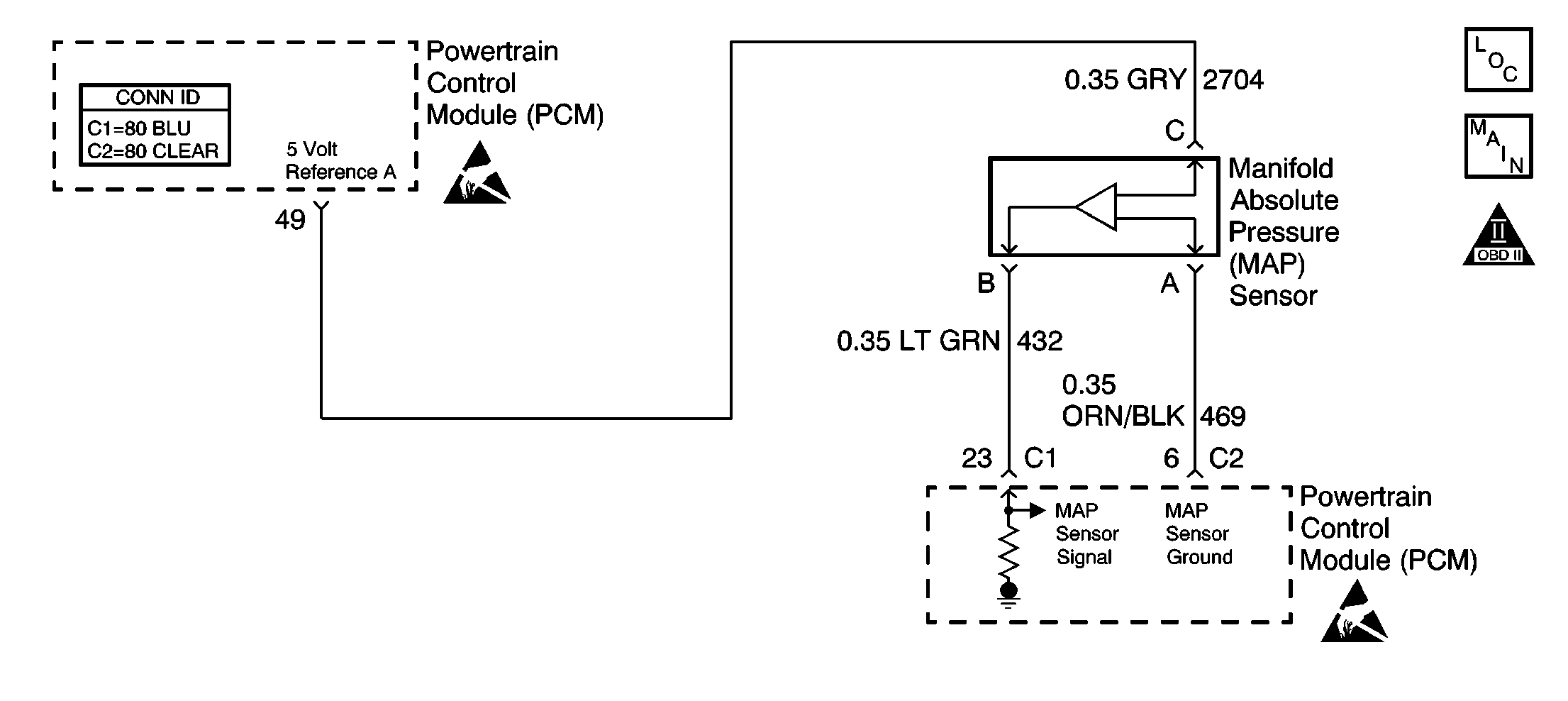
Circuit Description
The manifold absolute pressure (MAP) sensor responds to changes in intake manifold pressure. The PCM supplies a 5 volt reference and a ground for the MAP sensor. The MAP sensor provides a signal to the PCM relative to the pressure changes in the manifold. With low manifold absolute pressure (high vacuum such as during idle or deceleration), the PCM should detect a low MAP sensor signal voltage. With high manifold absolute pressure (low vacuum such as key ON, engine OFF or wide-open throttle), the PCM should detect a high MAP sensor signal voltage. The PCM tests the MAP sensor to ensure that the sensor is functioning properly. The PCM predicts a MAP sensor value based on throttle position and engine speed. The PCM then compares the predicted value to the actual MAP sensor input. DTC P0106 will set if the actual MAP sensor input does not closely match the predicted value.
Conditions for Running the DTC
| • | TP sensor DTCs are not set. |
| • | Engine speed is steady between 1000-4000 RPM. |
| • | Throttle angle is steady. |
| • | Idle air control valve is steady. |
| • | The A/C compressor clutch is steady. |
| • | The torque converter clutch is steady. |
| • | EGR is steady. |
| • | The vehicle brakes are not applied. |
Conditions for Setting the DTC
The actual MAP sensor value does not closely match the predicted value.
The conditions is present for 5 seconds.
Action Taken When the DTC Sets
| • | The PCM illuminates the malfunction indicator lamp (MIL) during the second consecutive trip in which the diagnostic test runs and fails. |
| • | The PCM stores the conditions present when the DTC set as Freeze Frame/Failure Records data. |
Conditions for Clearing the MIL/DTC
| • | The PCM will turn the MIL OFF after the third consecutive trip in which the diagnostic runs and passes. |
| • | The history DTC will clear after 40 consecutive warm-up cycles have occurred without a malfunction. |
| • | The DTC can be cleared by using the scan tool Clear DTC Information function. |
Diagnostic Aids
For intermittent conditions, refer to Symptoms .
Test Description
The numbers below refer to the step numbers on the diagnostic table:
-
Check for a proper MAP sensor voltage. With the key ON, and the engine OFF, the MAP sensor voltage should be between 4.5-5 volts.
-
Checks the MAP sensors ability to respond to an increase in vacuum.
-
Checks for a proper MAP sensor voltage with an applied vacuum. The MAP sensor voltage should be between 1-2 volts.
-
Checks the MAP sensors ability to respond to a sudden decrease in vacuum. With full release of the applied vacuum, the MAP sensor should return to a reading of 4.5-5 volts.
Step | Action | Values | Yes | No | ||||||
|---|---|---|---|---|---|---|---|---|---|---|
1 | Did you perform the Powertrain On Board Diagnostic (OBD) System Check? | -- | Go to Step 2 | |||||||
Does the scan tool indicate a MAP sensor voltage within the specified value? | 4.5-5V | Go to Step 3 | Go to Step 7 | |||||||
Important: Each 1 inch of vacuum applied should result in a 3-4 kPa drop in MAP sensor reading. Did a skip or jump in the sensor reading occur? | -- | Go to Step 7 | Go to Step 4 | |||||||
With 20 inches of vacuum applied to the MAP sensor, does the scan tool indicate a MAP sensor voltage within the specified range? | 1-2V | Go to Step 5 | Go to Step 6 | |||||||
Does the scan tool indicate a MAP sensor voltage within the specified value? | 4.5-5V | Go to Diagnostic Aids | Go to Step 7 | |||||||
6 |
Did you find and correct the condition? | -- | Go to Step 8 | Go to Step 7 | ||||||
7 | Replace the MAP sensor. Refer to Manifold Absolute Pressure Sensor Replacement . Is the action complete? | -- | Go to Step 8 | -- | ||||||
8 |
Does the scan tool indicate that DTC P0106 passed? | -- | System OK | Go to Step 2 |
